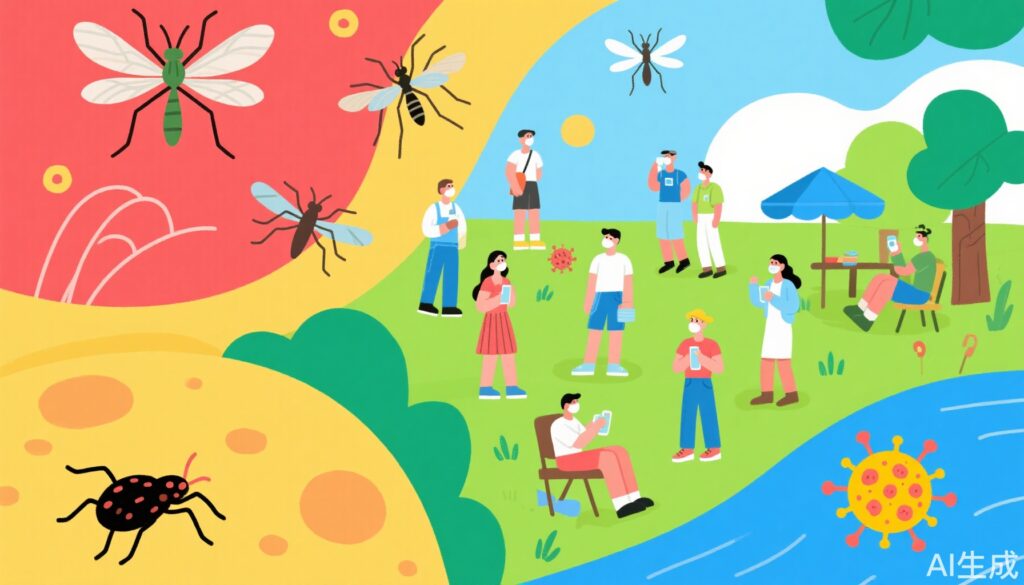Introduction
Summer is a season with increased risk of various infectious diseases due to favorable environmental conditions for vectors like mosquitoes and ticks, as well as increased outdoor activities. Understanding these diseases, their symptoms, transmission routes, and prevention methods is essential to reduce their impact on public health.
1. Severe Fever with Thrombocytopenia Syndrome (SFTS)
SFTS is a viral disease primarily found in mountainous and hilly areas, occurring year-round but more commonly in spring and summer.
Transmission
The main transmission route is through tick bites, especially from infected long-horned ticks. It can also spread via contact with blood, bodily secretions, excretions, or contaminated materials from infected animals or patients, especially if protective measures are not used.
Symptoms
The incubation period is 1 to 2 weeks. Symptoms include high fever (38–40°C), fatigue, poor appetite, nausea, vomiting, muscle aches, diarrhea, and occasionally mental confusion. Physical examination may reveal swollen and tender superficial lymph nodes in areas such as the groin, neck, and axilla. Severe cases can develop skin bruising, gastrointestinal or pulmonary bleeding, agitation, seizures, coma, and may lead to death due to circulatory or respiratory failure.
Prevention
- Wear long sleeves and pants during outdoor activities; tuck pants tightly; apply insect repellents containing DEET.
- Avoid sitting or lying in grassy or wooded areas for extended periods.
- Take a shower and check the whole body for ticks after returning indoors, especially underarms, behind ears, and groin.
- If a tick is found attached, do not forcibly remove it; use tweezers to grasp the head close to the skin and pull straight out, disinfect the wound, and save the tick for identification.
- Seek immediate medical attention if symptoms like fever, muscle pain, or gum bleeding appear, and inform medical staff about any tick exposure.
2. Chikungunya Fever
Chikungunya is an acute viral infection transmitted by Aedes mosquitoes, notably Aedes aegypti and Aedes albopictus.
Transmission
Primarily spread through bites from infected Aedes mosquitoes.
Symptoms
Patients experience sudden high fever (above 39°C) lasting 1 to 7 days, sometimes with a biphasic fever pattern (fever subsides then returns). Rash appears 2 to 5 days after onset, commonly on the face, limbs, palms, and soles, often itchy. Joint pain is severe and swollen, affecting small joints like wrists and fingers. Additional symptoms include headache, nausea, vomiting, muscle pain, and conjunctivitis. Rarely, severe complications such as bleeding, encephalitis, or myelitis can occur, potentially fatal.
Prevention
- Isolate and treat infected individuals promptly to control infection sources.
- Eliminate mosquito breeding sites by removing stagnant water from containers, plant trays, drains, mop buckets, and air conditioning drip pans.
- Use indoor mosquito repellents like coils and electric rackets to kill adult mosquitoes.
- Wear light-colored long-sleeved clothes and apply mosquito repellents before going outdoors.
- Travelers should learn about endemic diseases at destinations and take preventive measures since no vaccine or specific treatment is currently available.
3. Dengue Fever
Dengue is an acute mosquito-borne viral infection transmitted mainly via Aedes aegypti and Aedes albopictus mosquitoes.
Transmission
The disease spreads through the “patient-mosquito-other person” cycle; direct human-to-human transmission is rare.
Symptoms
Sudden onset of high fever, facial and upper body redness, severe headache, muscle and joint pain, eye pain, and sometimes rash appearing 3 to 6 days after fever onset. Bleeding tendencies, swollen lymph nodes, decreased white blood cell and platelet counts may also occur.
Prevention
- Ensure accommodations have screens on windows and use mosquito nets during sleep.
- Apply mosquito repellent to clothing every 4 hours when outdoors.
- Keep surroundings clean by removing stagnant water to reduce mosquito breeding.
- Seek prompt medical care if symptoms develop, especially after traveling to endemic areas.
4. Scarlet Fever
Scarlet fever is an acute respiratory infection caused by group A beta-hemolytic streptococci, mainly affecting young children during winter and spring.
Transmission
Spread through respiratory droplets and contact with contaminated objects, hands, or food; can also infect through broken skin.
Symptoms
Incubation period ranges from 1 to 12 days (commonly 2–5 days). Symptoms include high fever, sore throat, inflamed and sometimes pus-filled throat, characteristic “strawberry tongue” or “raspberry tongue,” pale ring around the mouth, rash followed by skin peeling.
Prevention
- Cover mouth and nose with tissue or cloth when coughing or sneezing, then wash hands promptly.
- Ventilate rooms regularly; disinfect children’s eating utensils and toys by boiling or cleaning with soapy water or sun exposure.
- Avoid crowded or poorly ventilated places during peak seasons; wear masks if unavoidable.
- Seek medical attention promptly if fever and rash occur during an outbreak.
5. Norovirus Infection-Induced Diarrhea
Norovirus is a leading cause of non-bacterial diarrhea outbreaks worldwide.
Symptoms
Incubation period is typically 24–48 hours (range 12–72 hours). Common symptoms include vomiting and diarrhea; other symptoms are nausea, abdominal pain, headache, fever, chills, and muscle aches. Adults tend to have more diarrhea, while children often vomit more.
Transmission
Primarily fecal-oral via contaminated food, water, objects, or aerosols from vomitus and feces. Contact with contaminated surfaces or aerosols can infect others, facilitating outbreaks.
Prevention
- Wash hands thoroughly before meals, after using the toilet, and before food preparation using proper seven-step technique with soap and running water for at least 20 seconds. Alcohol-based sanitizers are ineffective against norovirus.
- Do not drink untreated water; wash fruits and vegetables thoroughly; cook seafood and shellfish thoroughly.
- Isolate infected individuals for at least 3–4 days after symptom resolution, as viral shedding continues.
- Maintain suitable indoor temperature and ventilation; disinfect contaminated environments and items with chlorine-based agents.
- Adopt healthy lifestyle habits including regular rest, balanced nutrition, and moderate exercise to boost immunity.
6. Herpetic Pharyngitis
Herpetic pharyngitis is an acute viral infection caused by enteroviruses, characterized by fever and blistering ulcers in the throat.
Symptoms
Typical symptoms include mouth and throat blisters, fever, sore throat, and sometimes digestive symptoms like loss of appetite, nausea, vomiting, and abdominal pain. It is highly contagious with an incubation period of 3 to 5 days.
Prevention
- Wash hands frequently, especially before eating and after using the toilet, with soap or hand wash under running water.
- Ensure good ventilation by regularly opening windows and doors to maintain comfortable indoor air quality.
- Avoid crowded places during outbreaks.
- Thoroughly disinfect children’s toys, dishes, and clothing.
7. Acute Hemorrhagic Conjunctivitis (Red Eye Disease)
Acute hemorrhagic conjunctivitis is a highly contagious eye infection commonly referred to as “red eye.”
Symptoms
Sudden onset of conjunctival redness, burning sensation, itching, and increased eye discharge. Vision is typically not affected. Examination shows eyelid swelling and conjunctival hyperemia.
Transmission
The virus spreads through direct or indirect contact with contaminated items such as towels, money, basins, keyboards, keys, or door handles.
Prevention
- Maintain good personal hygiene; avoid rubbing eyes with unclean hands.
- Do not share towels, handkerchiefs, or basins with others.
- Disinfect items exposed to infected individuals by wiping or boiling.
- Avoid indiscriminate use of prophylactic eye drops to prevent cross-infection. Seek medical care promptly if symptoms develop.
Conclusion
Summer brings a heightened risk of various infectious diseases, many transmitted by vectors like mosquitoes and ticks or through close contact. Awareness of symptoms, transmission modes, and preventive strategies is crucial for individuals and communities to stay healthy. Timely medical consultation and adherence to preventive measures can greatly reduce disease burden and complications.


